Local Attractions
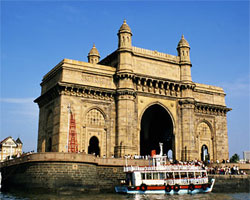
Gateway of India
It is one of the best pieces of architect British have left behind them in Mumbai. The monument was built to commemorate visit of King George V and Queen Marry to India in 1911. This grand, magnificent, attractive and most beautiful land mark stands regally at Apollo Bunder.
The monument was planned and designed by the veteran architect George Wittel. It is built of local yellow sand stone, popularly known as Malad Stone. The construction was completed in 1924.
The monument is built in Indo-Islamic style derived from a Gujrathi style of architect. The height of the central dome of the structure is 83 feet and its diameter is 48 feet in width. Because of its unique location, it can be prominently seen, both from the land and from a far distance in the Arabic sea. Motor launches are readily available here for a mini sea voyage in the surrounding sea water. Tourist can enjoy a short sea ride and see the light house and have a close view of the anchored ships.
After the dusk the sight of the Gateway of India from the sea water is breathtaking as the monument is illuminated in the evening with glowing flood lights. In recent years, after the independence, tall and a magnificent statue of Chhatrapati Shivaji has been installed in the premises. There is an another statue of swami Vivekanand in the vicinity of this land mark.
Not far from this place, are the world famous Elephanta Caves at a distance of 10kms. in the sea. Nearest Rly. Station: Churchgate, C.S.T. (V.T)
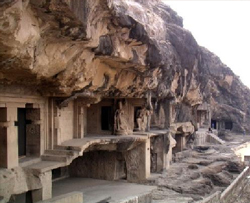
Elephanta Caves
The original old temple was built about 200 years ago. Since the old precinct of the temple could not accommodate the large number of devotees coming for darshan in crowds, the trustees of the temple renovated the temple in recent years. The present design of the temple is truly a beautiful piece of architectural skill.
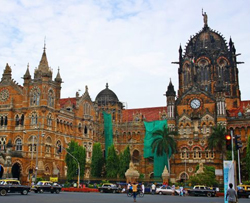
CST Station
Chhatrapati Shivaji Terminus formerly Victoria Terminus, is a UNESCO World Heritage Site and historic railway station which serves as the headquarters of the Central Railways in Mumbai, India.
Designed by Frederick William Stevens with influences from Victorian Italianate Gothic Revival architecture and traditional Mughal buildings, the station was built in 1887 in the Bori Bunder area of Bombay to commemorate the Golden Jubilee of Queen Victoria. The new railway station was built on the location of the Bori Bunder Station and is the busiest railway station in India, serving as both a terminal for long distance trains and commuter trains of the Mumbai Suburban Railway. The station's name was changed to its present one in March 1996 and is simply known as VT
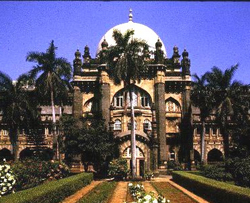
Prince of Wales Museum
The Chhatrapati Shivaji Maharaj Vastu Sangrahalaya, formerly Prince of Wales Museum of Western India is the main museum in Mumbai, formerly Bombay. It was founded in the early years of the 20th century by prominent citizens of Bombay, with the help of the government, to commemorate the visit of the then prince of Wales. It is located in the heart of South Mumbai near the Gateway of India. The museum was renamed in the 1990s or early 2000s after Shivaji, the founder of Maratha Empire.
The museum building is built in the Indo-Saracenic style of architecture, incorporating elements of other styles of architecture like the Mughal, Maratha and Jain. The museum building is surrounded by a garden of palm trees and formal flower beds.
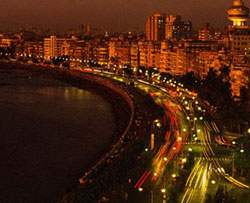
Marine Drive
It is a beautiful and elegant foreshore road constructed along the western seafront. This world famous Marine Drive, popularly known as 'Queen's Necklace', was completed in 1940. This road starts from Nariman Point and passes along the seafront with a majestic semicircular curve to reach at the foot of Malabar Hill. Number of residential buildings and bungalows, with uniform height and design, painted in white and off-white colors, lined up along the other side of the road gives a very exceedingly charming look at this road.
However, at night the entire scenery changes. The road gets illuminated because of the flooding of street lights. The penetrating beam lights of speeding vehicles cut down the surrounding darkness like a powerful torch and pour showers of light on the entire area. It seems, as if a melted gold in a furnace is poured down on the earth to flow down in a stream. in the season of monsoon the sight of the illuminated road in the night looks like a golden necklace. Nearest Rly. Station: Churchgate (V.T)
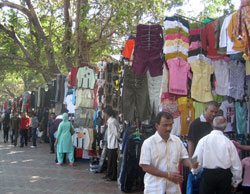
Fashion Street
The open street market spread over the long footpath along the Cross Maidan, opposite the Bombay Gymkhana, has become a very popular market place in the recent years. This open market place has been created for hawkers who sold readymade garments from at very low price. Along with garments many other articles such as leather goods, antiques, electronic goods, scents, hosiery, purses and dress material. are sold here at cheaper rates. Nearest Rly. Station: Churchgate (W.R.), C.S.T. (V.T.)
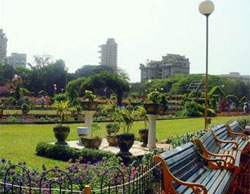
Malabar Hill, Hanging Garden - Kamala Nehru Park
These two parks are situated at the top of the Malabar Hill and are visited almost all who pay visit to Mumbai. It was the British Governor Elphinstone, who first of all built a palatial bungalow for his own use on the Malabar Hill The area afterwards went series of development during the last century.
According to the old records the area of Malabar Hill was sparsely populated till the seven islands of Mumbai were joined together by the British. People visited the old Walukeshwar Temple, built by the Shilahara kings sometime in 8th or 9th century. It has been mentioned in the old records that prominent personalities like Chhatrapati Shivaji , Kanhoji Anger and Raghunathrao Peshwa visited Walkeshwar few times to perform religious rites at Banganga. The areas, otherwise, was in seclusion.
The construction of The Hanging Garden on Malabar Hill was a part of their efforts to augment the water supply to the city. The Hanging Garden is a water supply scheme implemented in 1880 with a beautiful garden at the top and three underground water tanks below it. The water supply scheme has a storage capacity of quite a large quantity of water for ready supply. The garden, was once again renovated in 1921. The birds eye view of the Marine Drive and the vast expanse of the Arabian sea from here is thrilling and spectacular. One can have a picturesque view of Mumbai vastly expanded in the south up to Cuffe Parade.
Adjoining the Hanging Garden is the Kamala Nehru Park. The park, covering an area of about 4000 sq. meters, was developed in 1952. Nearest Rly. Station: Grant Road (W.R.)
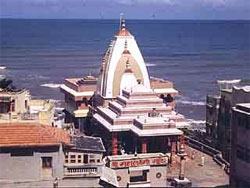
Mahalaxmi Temple
This is one of the old and famous temple in Mumbai. The temple stands in the north of Malabar Hill, near Worli sea-shore. Three idols of goddesses namely Mahalaxmi, Mahakali and Mahasaraswati are installed in this temple. Devotees throng here on Tuesdays, Fridays and also during Navratri Festival.
According to the old records the original temple of Mahalaxmi was as old as that of Walukeshwar. But the temple was demolished and destroyed by the Muslim envaders in medieval period.
According to a legend the alive deities disappeared into the sea at the time of invasion and were found by an engineer after a long search in the sea at Worli. The knowledgeable sources say that the engineer from the Prabhu Community, who was in charge of the linkage work between Malabar hill and Worli, undertaken during the tenure of William Hombey, was very much disappointed due to his failure in the work he undertook. The work of constructing rampart was not coming up in any case. It used to slide down again and again. One day, as he was worried about his failure, he had a vision of the three goddesses in a dream. The goddesses asked him to pick up their idols lying at the sea bottom at Worli and build a temple for them. They also graced him for his success in the construction work. The engineer accordingly made a search for these idols and found them at Worli sea. He brought them ouitand installed them for the time being at a place where the temple at present is located. Built a spacious temple for the salvaged idols. The temple stands at the place for more than 100 years with a glorious past and mystic legendary.
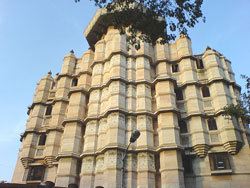
Siddhivinayak Mandir
The original old temple was built about 200 years ago. Since the old precinct of the temple could not accommodate the large number of devotees coming for darshan in crowds, the trustees of the temple renovated the temple in recent years. The present design of the temple is truely a beautiful piece of architectural skill.
The temple situated at Prabhadevi, at a short distance from Dadar, is a popular place of worship in Mumbai.
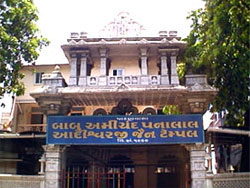
Jain Mandir
One of the oldest Jain Mandir in Mumbai stands on the Ridge Road in the Malabar Hill area. The temple was built in 1904 with marble stone and beautiful carving on its exterior part. Figures of various animals and birds, artistically carved in the marble stones, are displayed on the front part of this temple. It is one of the important temple and old place where the jain devotees go for daily worship.
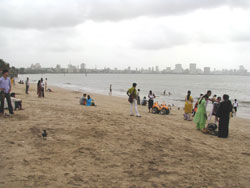
Girgaon Beach - Chowpatty
Chowpatty occupies a very special place in the life of people in Mumbai. The Chowpatty has witnessed many historic events in the pre-independence and also in the post independence period. The place has also witnessed many mass political meetings addressed by the topmost leaders of India. People crowd in here on two important occasions every year, one being the immersion ceremony of Lord Ganesha during the Ganesha Festival and the other the Coconut Day when the fishing folk offer coconuts to the sea in gratitude and reverence. It is only after the completion of the Marine Drive the place became very much busy and crowded. However, people so visit this place often for a change in the daily routine. The two statues erected on this beach are those of Lokmanya Tilak and Vithalbhai Patel. Nearest Rly. Station: Charni Road (W.R.).

